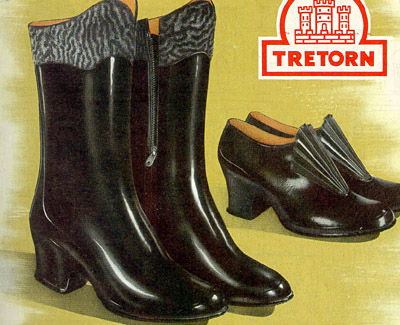| Dunker

| | Dunker- familien, der grundlagde og udviklede Tretorn imperiet, kom til Helsingborg fra Danmark.
Det blødgjorte gummi er et godt eksempel på kemiprodukt, som dannede udgangspunkt for produktion af moderne forbrugsvarer af høj kvalitet. Gummialderen havde taget sin begyndelse i Øresundsregionen.
Dunkers anvendte store dele af deres formue til gavn for kulturlivet i Helsingborg. |
Galoche-kongen
Dunker- familien, der grundlagde og udviklede Tretorn imperiet, kom til Helsingborg fra Danmark.
Det blødgjorte gummi er et godt eksempel på kemiprodukt, som dannede udgangspunkt for produktion af moderne forbrugsvarer af høj kvalitet. Gummialderen havde taget sin begyndelse i Øresundsregionen.
Dunkers anvendte store dele af deres formue til gavn for kulturlivet i Helsingborg.
Gummialderen
Gummi havde været i brug i lang tid og det fungerede udmærket - som viskelæder. En metode som åbnede helt andre muligheder for udnyttelsen af gummi, blev opdaget af amerikaneren Charles Goodyear i 1839. Det var lykkedes ham at forædle rågummi til et materiale, som var blødt, vandtæt og holdbart. Metoden blev kaldt vulkanisering og var, teknisk set, en opvarmning af en blanding af kautsjuk og svovl. Man fik hermed helt nye muligheder for at udnytte gummi industrielt.
En idé, blandt mange andre, var at fremstille en beskyttende sko, som skulle bæres udenpå elegante sko ved regn og snavset føre. Galochen, den franske betegnelse for en overtrækssko, var født! Vintrene ved Øresund ville fra nu af blive mere udholdelige med de nye vind- og vandtætte sko. Galocher blev umådeligt populære og fremstilledes rundt om i verden. Sverige importerede fortrinsvis nyheden fra Rusland.
Johan Dunker – begyndelsen
I Helsingborg fandtes en havnefoged som hed Johan Dunker. Han kom oprindelig fra Slesvig-Holsten. Familien Dunker boede i Esbjerg da sønnen Henry blev født i 1870. Johan, som var aktiv indenfor Helsingborgs næringsliv, forstod at efterspørgslen på gummivarer ville øge. Med tidens fremskridtsoptimisme for øje turde han satse på, at anlægge en gummifabrik i det kraftigt voksende Helsingborg. Med støtte fra bl.a. Petter Olsson grundlagdes AB Helsingborgs gummifabrik i 1891.

Johan Dunker |
Henry Dunker – udviklingens mand
Johan Dunkers søn, Henry, rejste til Rusland for at indhente ”knowhow” til den nye fabrik. I Skt. Petersborg var fremgangen ringe, men i Riga, som den gang tilhørte Rusland, fik han kontakt med en kemiker, som var interesseret i at udvikle Helsingborgsfabriken. Han hed Julius von Gerkan og han kunne høste megen hæder for at Helsingborgsgalocherne fik en så høj kvalitet.
Henry Dunker blev disponent i 1894 og efter nogle genvordigheder i starten kunne fabrikken udvides. Han arbejde hårdt for at styrke sin stilling i forhold til andre gummifabrikker. Således overtog han gummifabrikken Velox i Trelleborg og etablerede i 1905 Trelleborgs gummifabrik, som derved blev en del af Dunkers voksende imperium. En af hans idéer var, at starte sine egne salgskontorer, og derved undgå at sælge via grossister. På den måde kunne han få kontrol over en større del af kæden fra producent til konsument.
Salgskontorer åbnede mellem 1910-og 20alle dele af Sverige, men også i udlandet, f.eks. København (1909), Berlin (1913) og Wien (1913). Det var ikke kun virksomheden som udvikledes men også vareudbuddet. Det som begyndte med galocher og andre slags gummisko, fortsatte nu med bolde, badehætter og dæk. Henry Dunker indså værdien af specialisering og forlagde f.eks. produktionen af dæk til Trelleborg.

Henry Dunker |
Kartel og koncern
For at opnå en bedre konkurrencesituation i udlandet og undgå konkurrence på hjemmemarkedet etableredes, på Henry Dunkers initiativ, et kartel i 1912. Resultatet blev at priserne kunne forhøjes i Sverige og sænkes i udlandet, hvilket gav en højere gevinst.
Under 30ernes depression ville mange stater beskytte deres egen produktion ved hjælp af toldafgifter og importforbud. Henry Dunker anlagde fabrikker i Hamburg og Helsingør, og kunne således opretholde produktion og salg i Tyskland og Danmark. Fabrikken i Helsingør, som grundlagdes i 1935, voksede støt og var i slutningen af 50erne byens næststørste arbejdsplads med over 1000 ansatte. Det gamle ”Helsingborgs Gummifabrik AB” var vokset op til en multinational koncern og virksomheden havde skiftet navn til ”Tretorn AB”. Dette for at slippe for det gamle navns provinsielle klang.

Tretorn i Helsingør | 
Reklame for Tretorn, 1939 |
Sveriges rigeste mand
Efterspørgslen på gummivarer blev enorm. Fra kun at blive brugt som viskelæder voksede udbuddet via gummisko til bildæk, cykeldæk, regntøj, bolde, gymnastiksko, elastikker, tætningslister, ja listen er næsten ubegrænset, og 30erne og 40erne blev med rette kaldt ”gummi-alderen”. Frugterne af denne fremgang gjorde ”galosche-kongen” Henry Dunker til Sveriges måske rigeste mand.
Henry Dunkers villa som blev bygget i 20erne på ”landborgen” i det nordlige Helsingborg, og giver et godt indblik i det velstillede borgerskabets miljø.

Dunkers villa | 
Arbejderkvarter | 
Bruserum |
Arbejdsgiveren Dunker
Henry Dunkers lederevner kan beskrives som: hård mod de hårde, men lidt blødere mod de svage. Jo højere position man havde i koncernen, jo mere krævende var Dunker. Han var heller ikke en ven af faglige organisationer og arbejdsnedlæggelser, og det var naturligvis ikke for at spille rolle som velgører at han engagerede sig i storkapitalistisk virksomhed.
Da han allerede i 1911 etablerede en privat børnehave, var det for at virksomheden kunne ansætte flere kvinder. I 1930erne var størstedelen af de ansatte ved gummifabrikken i Helsingborg således kvinder.

Fagforeningsfane | 
Vuggestue 1916 |
Kommunen som arving
Ind imellem kunne Dunker også vise velvilje og eftergive en eller anden fordring, men den slags gjaldt næsten kun hans egne arbejdere. Personalet i hans villa, Hevea, kunne godt lide ham.
Dunkers formue blev, ved hans død i 1962, testamenteret til Helsingborgs Kommune, og hans villa blev lavet om til plejehjem. På den måde blev hans mange penge givet tilbage til folk i byen. Uden disse midler ville Helsingborg ikke kunne tilbyde sine borgere det teater og det kulturhus som nu pryder byen. Man må dog ikke glemme de tusinder af mennesker, som arbejdede og sled i snavsede og ildelugtende fabrikker.

Dunkers kulturhus |
|